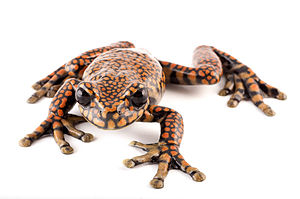Hyloscirtus princecharlesi
| Hyloscirtus princecharlesi | ||||||||||||
|---|---|---|---|---|---|---|---|---|---|---|---|---|

Hyloscirtus princecharlesi , male |
||||||||||||
| Systematics | ||||||||||||
|
||||||||||||
| Scientific name | ||||||||||||
| Hyloscirtus princecharlesi | ||||||||||||
| Coloma , Carvajal-Endara , Dueñas , Paredes-Recalde , Morales-Mite , Almeida-Reinoso , Tapia , Hutter , Toral & Guayasamin , 2012 |
Hyloscirtus princecharlesi is afrog species from the family of tree frogs iwS (Hylidae)occurringin Ecuador . The first describer dedicated the species to the heir to the throne of the United Kingdom Charles, Prince of Wales , who has madegreat contributions to nature and species protectionwith his commitment to end tropical deforestation . In particular, he tries to prevent the extinction of rainforest amphibians. His Rainforest SOS campaign includes a video with a frog as a rainforest ambassador.
features
So far only males have been measured. Their head-to-torso length (SVL) is between 68.1 and 70.5 millimeters. The basic color of the entire upper side of the body including the legs is dark gray and thickly covered with orange spots. Tubercles are largely absent. Head length and width are roughly the same dimensions. The upper and especially the forearms are robust, as are the rear extremities, which have a tibia length of 46.5% and a foot length of 44.7% of the SVL. The underside of the body is whitish-gray and has an irregular, coarse pattern of black spots. The iris is dark gray.
Similar species
- Hyloscirtus pantostictus differs in that the many orange-colored spots on the upper side of the body are very small, almost point-like, as well as by the conspicuous yellow end links of the fingers, whichare grayin Hyloscirtus princecharlesi .
- In Hyloscirtus ptychodactylus , the orange-colored pattern of spots is more extensive and the spots sometimes merge with one another. It is also distinguished by a sky-blue colored iris.
Occurrence, habitat and way of life
Hyloscirtus princecharlesi has so far only been detected in a small area on the edge of the Ecuadorian nature reserve Cotacachi Cayapas in the province of Imbabura at altitudes between 2720 and 2794 meters. The animals live in damp, bushy areas on river banks. They are active in the evening and night.
Danger
Hyloscirtus princecharlesi is threatened by humans in its habitats due to the planned land use of its occurrence areas. The discoverers recommended for type therefore the status of " endangered = critically endangered" according to the classification of the World Conservation Union IUCN . Climatic changes are also likely to have a negative impact on the development of the species.
Individual evidence
- ↑ a b c d e Luis Aurelio Coloma, Sofía Carvajal-Endara, Juan Fernando Dueñas | Dueñas, Arturo Paredes-Recalde, Manuel A. Morales-Mite, Diego Almeida-Reinoso, Elicio E. Tapia, Carl R. Hutter, Eduardo Toral , Juan M. Guayasamin: Molecular phylogenetics of stream treefrogs of the Hyloscirtus larinopygion group (Anura: Hylidae), and description of two new species from Ecuador . In: Zookeys No. 3364, 2012, pp. 1–78, http://www.mapress.com/zootaxa/2012/f/zt03364p078.pdf
- ^ Environmental activist Prince Charles . In: Der Spiegel, July 5, 2012
Web links
Hyloscirtus princecharlesi at the National Center for Biotechnology Information (NCBI)